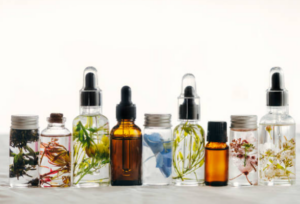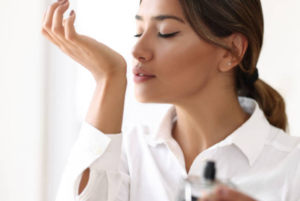Unraveling the Ingredients Behind the Scent

In the realm of cosmetics, fragrance is a beguiling enigma—a sensory journey that transports us to memories, emotions, and even our sense of identity. The mere hint of a beloved scent can evoke nostalgia, spark joy, or create a signature impression. Yet, behind the delicate veil of fragrance lies a hidden narrative of potential hazards, especially in the realm of cosmetics. The deceptively innocent term “fragrance” on cosmetic labels harbors a concealed complexity of undisclosed ingredients that can harbor detrimental effects on our health and overall well-being. In this expansive exploration, we peel back the layers of the hidden dangers of fragrance in cosmetics, unveiling the intricate ingredients concealed behind the alluring scent and the far-reaching implications for our skin, health, and environment.
Fragrance is a force that defies boundaries—both tangible and intangible. Its ethereal presence in cosmetics holds the power to transform a mundane routine into a sensory experience, leaving an indelible mark on our emotions and memories. Yet, this captivating allure is paradoxically entwined with a complex web of ingredients that range from natural extracts to synthetic compounds. The term “fragrance,” though enchanting, obscures the intricate composition that lies beneath the surface, often encompassing an amalgamation of substances that might not be as benign as their aromatic exterior suggests.
The Fragrance Paradox
Fragrance, the ethereal essence that can encapsulate memories, spark emotions, and define personal identity, is both an art and a science. In the realm of cosmetics, fragrance holds an undeniable allure, capable of transforming the mundane act of applying makeup or skincare into an enchanting sensory experience. Yet, this captivating aroma conceals a complex paradox—simultaneously an aesthetic treasure and a scientific labyrinth of potentially hazardous ingredients. As we explore the fragrance paradox, we embark on a journey to unveil the enchantment and complexity that lie within the scented world of cosmetics.
Fragrance is a language that transcends words, speaking to the soul through the senses. The scent of a particular perfume, lotion, or cosmetic can transport us to cherished moments, evoke emotions, and even evoke the presence of a loved one. This remarkable power lies in the intricate chemical compounds that form the basis of fragrances. The composition of these compounds is carefully orchestrated to create olfactory symphonies that resonate uniquely with each individual.
The role of fragrance in cosmetics goes beyond its sensory appeal; it plays a pivotal role in the aesthetic enhancement of beauty products. A delightful scent can elevate the application experience, making it more pleasurable and engaging. Fragrance can also contribute to the overall image of a product, evoking a sense of luxury, freshness, or playfulness, depending on the chosen scent.
Potential Health Concerns
Sensitive Skin and Irritation: The complex blend of fragrance compounds can cause skin irritation, particularly for those with sensitive skin. Redness, itching, and a burning sensation are common manifestations that disrupt the joy of using scented cosmetics.
Allergic Reactions: The veiled components within fragrances can trigger allergic reactions in susceptible individuals. From hives and swelling to eczema flare-ups, the allure of fragrance can swiftly transform into a source of discomfort.
Contact Dermatitis: Fragrance allergens are notorious for causing contact dermatitis—a condition marked by red, itchy, and inflamed skin upon contact with a specific substance. This condition can hinder our ability to fully enjoy the products we love.
Scent-Induced Respiratory Sensitivity: Inhaling fragrance chemicals can lead to respiratory discomfort, especially for individuals with asthma or other preexisting respiratory conditions. The very fragrance that enhances our beauty routine might compromise our lung health.
Airborne Irritants: Volatile organic compounds (VOCs) released by fragrances can contribute to indoor air pollution, impacting indoor air quality and potentially exacerbating respiratory issues.
Phthalates and Endocrine Disruption: Certain fragrance ingredients, notably phthalates, have been associated with endocrine disruption—a phenomenon where synthetic chemicals interfere with the delicate balance of hormones in the body. This disruption can lead to a range of health issues, including reproductive and developmental concerns.
Potential Impacts on Fertility: The subtle fragrance that graces our skin could potentially harbor chemicals that pose risks to reproductive health, impacting fertility and hormonal balance.

Unseen Carcinogens: The hidden ingredients in fragrances might include substances classified as potential or known carcinogens. These chemicals have the potential to increase the risk of cancer over time, casting a somber shadow on the sensory delight of fragranced products.
Synthetic Fragrances and Environmental Pollution: The very compounds that create captivating scents might contribute to environmental pollution. Synthetic fragrance ingredients, derived from petrochemicals, can enter water bodies, soil, and the air, impacting ecosystems and wildlife.
Ecosystem Disruption: The introduction of synthetic fragrance chemicals into natural ecosystems can disrupt the delicate balance of wildlife and aquatic life, potentially leading to unintended consequences for the environment.
Deciphering the Terminology
The vague terminology used to describe fragrance ingredients on cosmetic labels can be misleading. Here are some terms commonly used and what they mean:
A Blend of Secrets: The term “fragrance” on cosmetic labels implies a unique blend of aromatic compounds that create the product’s distinct scent. It’s akin to a proprietary recipe, with each brand guarding its formulation closely.
Mystery in Every Drop: While the allure of fragrance is undeniable, the concealed complexity can encompass a range of natural and synthetic ingredients, some of which may be problematic for our skin and health.
The Perfumer’s Palette: Often used interchangeably with “fragrance,” the term “parfum” signifies a more potent concentration of aromatic compounds. It’s the hallmark of a brand’s signature scent, an olfactory masterpiece created by skilled perfumers.
A Touch of Luxury: Products bearing the label “parfum” often evoke a sense of luxury, sophistication, and exclusivity, catering to those who seek a higher level of olfactory experience.
Empower Yourself with Knowledge
Choose Unscented or Fragrance-Free: Opt for products labeled as “unscented” or “fragrance-free.” Unscented products may still contain masking scents, while fragrance-free products generally don’t contain added scents.
Transparency Matters: Seek brands that disclose specific fragrance components in their products. Some companies are adopting this transparency to empower consumers.
Read Ingredient Lists: Look for specific fragrance components like limonene, linalool, and benzyl salicylate, which are common allergens found in many fragrances.
Educate Yourself: Familiarize yourself with organizations and resources that provide information about cosmetic ingredients and their potential risks.
The Art of Ingredient Label Scrutiny: Train your eye to read ingredient labels meticulously. Familiarize yourself with common fragrance allergens such as limonene, linalool, and benzyl salicylate, which might trigger skin reactions.
Glossary of Allergens: Compile a list of fragrance allergens and familiarize yourself with their alternative names. This knowledge empowers you to identify potential risks within the scent profile of products.

Prioritizing Sensitivity: If you have sensitive skin or are prone to allergies, consider opting for products labeled as “unscented” or “fragrance-free.” Unscented products might contain masking fragrances, while fragrance-free products exclude added scents altogether.
Safeguarding Skin Health: Making choices that align with your skin’s sensitivities is an act of self-care. Fragrance-free alternatives can provide the beauty experience you seek without the hidden risks.
The Power of Choice: The consumer’s journey in the world of fragranced cosmetics begins with choice. By educating ourselves, reading labels, and seeking transparency, we wield the power to make informed decisions that resonate with our health and values.
Demanding Transparency: Empowered consumers call for transparency. We advocate for brands that willingly disclose fragrance ingredients, reinforcing the importance of knowing what we apply to our skin.
A Voice for Change: Consumer demand shapes the industry landscape. By supporting brands prioritizing safety, transparency, and ethical practices, we send a message—a call for change that resonates far beyond the beauty aisle.
Ethical Formulation: The beauty industry’s responsibility extends beyond aesthetics. Brands are entrusted with our well-being. By formulating products with safety in mind, they bridge the gap between allure and accountability.
Transparency as Norm: Industry leaders can set new standards by embracing transparency as the norm. Openly disclosing fragrance components fosters trust and empowers consumers to make choices aligned with their sensitivities.
Innovating for Safety: Embracing innovation, the industry can develop fragrance alternatives that minimize risks without compromising sensory delight. This shift demonstrates a commitment to holistic beauty experiences.
Education as a Pillar: Empowerment through education becomes the cornerstone of change. Educating consumers about the complexities of fragranced products equips them to navigate the labyrinth of hidden hazards.
Open Dialogue: Consumer-Industry collaboration fuels progress. Forums for discussion, feedback, and sharing experiences enable the industry to comprehend evolving sensitivities and tailor offerings accordingly.

Collective Responsibility: A shared responsibility emerges—a dance between consumers and the industry. As consumers prioritize informed choices, the industry responds with transparency, ethical practices, and safer formulations.
The pursuit of beauty should never come at the expense of our health or the environment. By unraveling the ingredients behind the scent, we can make informed choices that prioritize our well-being. Remember that your health and the health of our planet are interconnected, and by advocating for transparency, we can work toward a safer, more conscious beauty industry. Let’s collectively embark on a journey to embrace beauty products that enhance our lives without compromising our health.




